tow MERCEDES-BENZ SPRINTER 2012 MY12 Operator’s Manual
[x] Cancel search | Manufacturer: MERCEDES-BENZ, Model Year: 2012, Model line: SPRINTER, Model: MERCEDES-BENZ SPRINTER 2012Pages: 292, PDF Size: 6.75 MB
Page 57 of 292
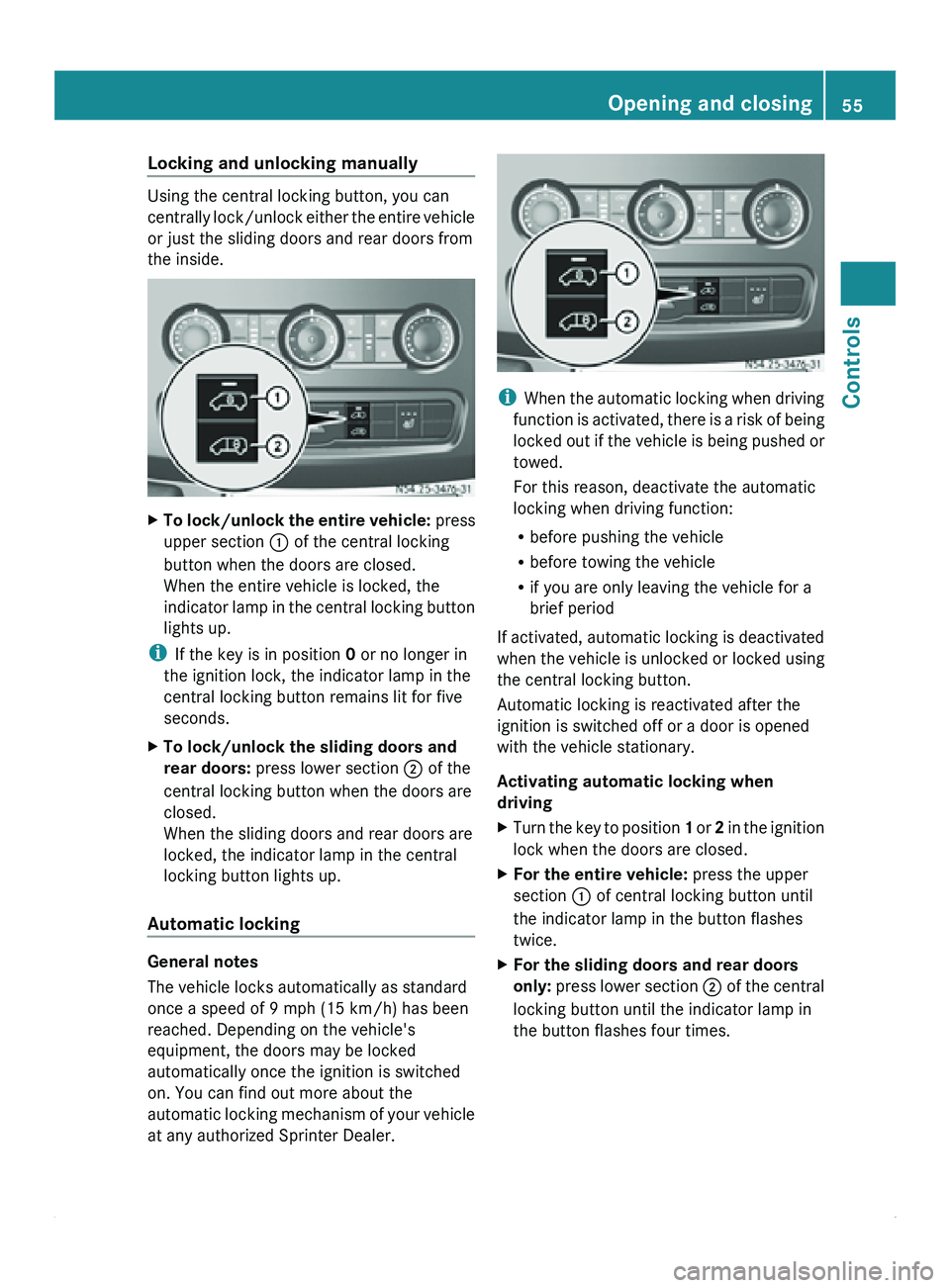
Locking and unlocking manually
Using the central locking button, you can
centrally lock/unlock
either
the entire vehicle
or just the sliding doors and rear doors from
the inside. X
To lock/unlock the entire vehicle: press
upper section 0046 of the central locking
button when the doors are closed.
When the entire vehicle is locked, the
indicator lamp in
the central locking button
lights up.
i If the key is in position 0 or no longer in
the ignition lock, the indicator lamp in the
central locking button remains lit for five
seconds.
X To lock/unlock the sliding doors and
rear doors: press lower section 0047 of the
central locking button when the doors are
closed.
When the sliding doors and rear doors are
locked, the indicator lamp in the central
locking button lights up.
Automatic locking General notes
The vehicle locks automatically as standard
once a speed of 9 mph (15 km/h) has been
reached. Depending on the vehicle's
equipment, the doors may be locked
automatically once the ignition is switched
on. You can find out more about the
automatic locking
mechanism
of your vehicle
at any authorized Sprinter Dealer. i
When the automatic
locking when driving
function is activated, there is a risk of being
locked out if the vehicle is being pushed or
towed.
For this reason, deactivate the automatic
locking when driving function:
R before pushing the vehicle
R before towing the vehicle
R if you are only leaving the vehicle for a
brief period
If activated, automatic locking is deactivated
when the vehicle is unlocked or locked using
the central locking button.
Automatic locking is reactivated after the
ignition is switched off or a door is opened
with the vehicle stationary.
Activating automatic locking when
driving
X Turn the key to position 1 or 2
in the ignition
lock when the doors are closed.
X For the entire vehicle: press the upper
section 0046 of central locking button until
the indicator lamp in the button flashes
twice.
X For the sliding doors and rear doors
only: press lower
section 0047 of the central
locking button until the indicator lamp in
the button flashes four times. Opening and closing
55
Controls Z
Page 59 of 292

G
Warning
If the vehicle is parked on an incline, the
sliding door may move of its own accord if it
is open but
not engaged. You and others could
then become trapped.
Make sure that the sliding door is engaged in
the active retainer.
The sliding door is equipped with an active
retainer, which engages the door at the end
stop when opened.
i You can also lock the sliding door in place
around halfway when opening/closing. If
you do this, the door does not have to be
opened fully when getting into or out of the
vehicle. The intermediate detent does not
fully engage the sliding door. Opening/closing the sliding door from
the outside
X
To open: pull door handle 0046
to open the
sliding door.
X Slide the sliding door by handle 0046 back
to
the stop.
X Check the sliding door detent.
The sliding door must be engaged.
X To close: pull
door handle 0046
in the "close
door" direction, to release the sliding door
from the detent.
X Holding door handle 0046, slide the door
firmly towards the front until it engages. Opening/closing the sliding door from
the inside X
To unlock: pull locking knob
0088 upwards.
Only this sliding door unlocks. All other
doors that were previously locked remain
locked.
X To open: press button 0047 to open the
unlocked sliding door.
X Slide the sliding door by handle 008A back
to
the stop.
X Check the sliding door detent.
The sliding door must be engaged.
X To close: slide the sliding door firmly
forwards by handle 008A
until it engages.
X To lock: press locking knob 0088 down.
Only the sliding door is locked. All other
doors that were previously unlocked
remain unlocked.
Electrical closing assist If your vehicle is fitted with electrical closing
assist, you
will
require less force to close the
sliding door. G
Warning
Make sure that nobody can become trapped
as you close the sliding door.
If there is a risk of entrapment, pull the
outside door handle
or press the button on the
inside door handle and open the door. Rear doors
You can lock
the rear doors at an angle of 90°,
180° and 270°. Always make sure that the
open rear door is correctly engaged in the
detent.
! Make sure that there is sufficient
clearance when opening the rear doors.
You could otherwise damage the vehicle
and objects in close range of the rear doors. Opening and closing
57
Controls Z
Page 64 of 292
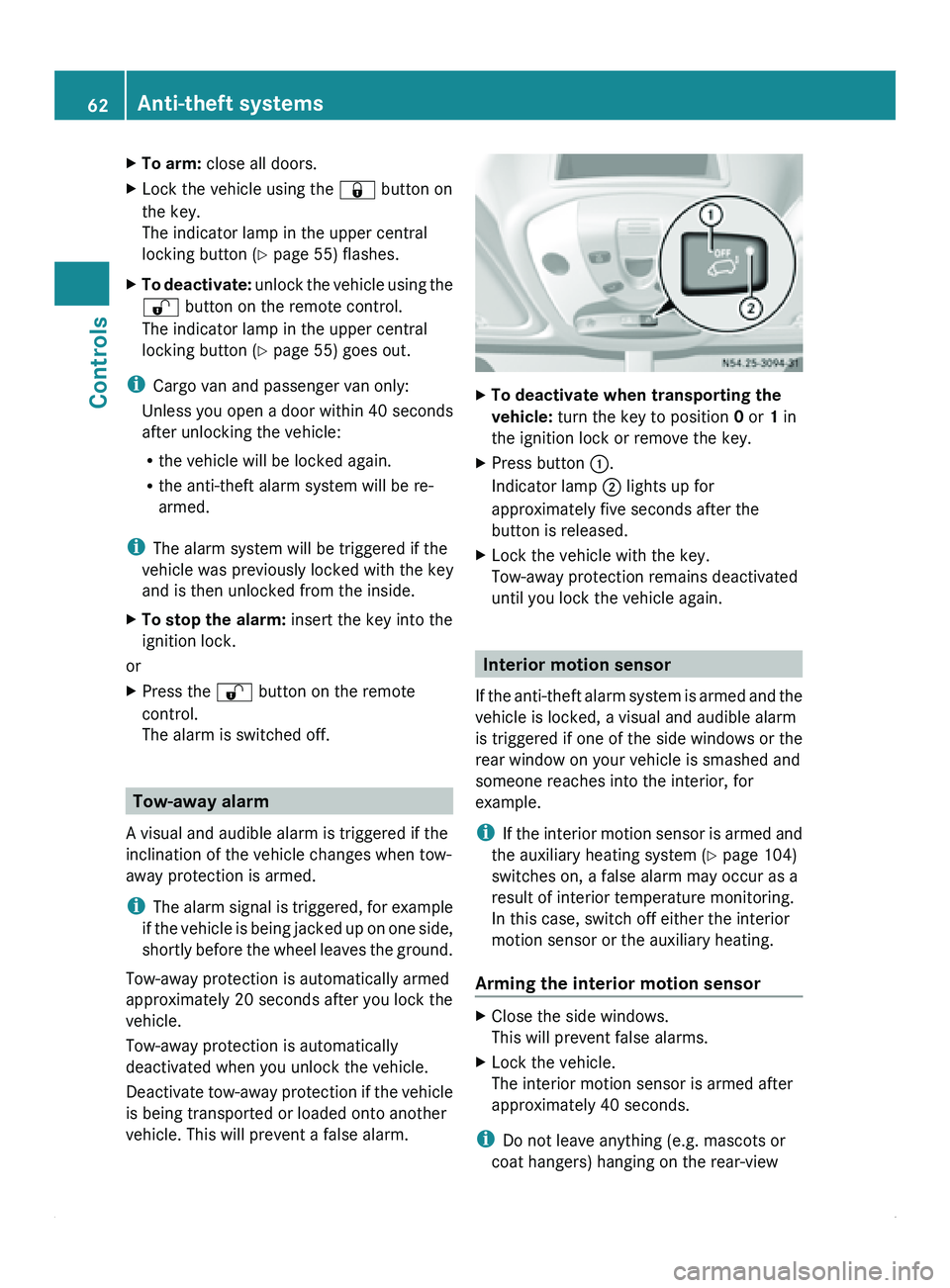
X
To arm: close all doors.
X Lock the vehicle using the 0037 button on
the key.
The indicator lamp in the upper central
locking button ( Y
page 55) flashes.
X To deactivate: unlock the
vehicle using the
0036 button on the remote control.
The indicator lamp in the upper central
locking button (Y page 55) goes out.
i Cargo van and passenger van only:
Unless you open
a door within 40 seconds
after unlocking the vehicle:
R the vehicle will be locked again.
R the anti-theft alarm system will be re-
armed.
i The alarm system will be triggered if the
vehicle was previously locked with the key
and is then unlocked from the inside.
X To stop the alarm: insert the key into the
ignition lock.
or
X Press the 0036 button on the remote
control.
The alarm is switched off. Tow-away alarm
A visual and audible alarm is triggered if the
inclination of the vehicle changes when tow-
away protection is armed.
i The alarm signal
is triggered, for example
if the vehicle is being jacked up on one side,
shortly before the wheel leaves the ground.
Tow-away protection is automatically armed
approximately 20 seconds after you lock the
vehicle.
Tow-away protection is automatically
deactivated when you unlock the vehicle.
Deactivate tow-away protection if the vehicle
is being transported or loaded onto another
vehicle. This will prevent a false alarm. X
To deactivate when transporting the
vehicle: turn the key to position 0 or 1 in
the ignition lock or remove the key.
X Press button 0046.
Indicator lamp 0047 lights up for
approximately five seconds after the
button is released.
X Lock the vehicle with the key.
Tow-away protection remains deactivated
until you lock the vehicle again. Interior motion sensor
If the anti-theft
alarm system is armed and the
vehicle is locked, a visual and audible alarm
is triggered if one of the side windows or the
rear window on your vehicle is smashed and
someone reaches into the interior, for
example.
i If the interior motion sensor is armed and
the auxiliary heating system (Y page 104)
switches on, a false alarm may occur as a
result of interior temperature monitoring.
In this case, switch off either the interior
motion sensor or the auxiliary heating.
Arming the interior motion sensor X
Close the side windows.
This will prevent false alarms.
X Lock the vehicle.
The interior motion sensor is armed after
approximately 40 seconds.
i Do not leave anything (e.g. mascots or
coat hangers) hanging on the rear-view 62
Anti-theft systems
Controls
Page 66 of 292
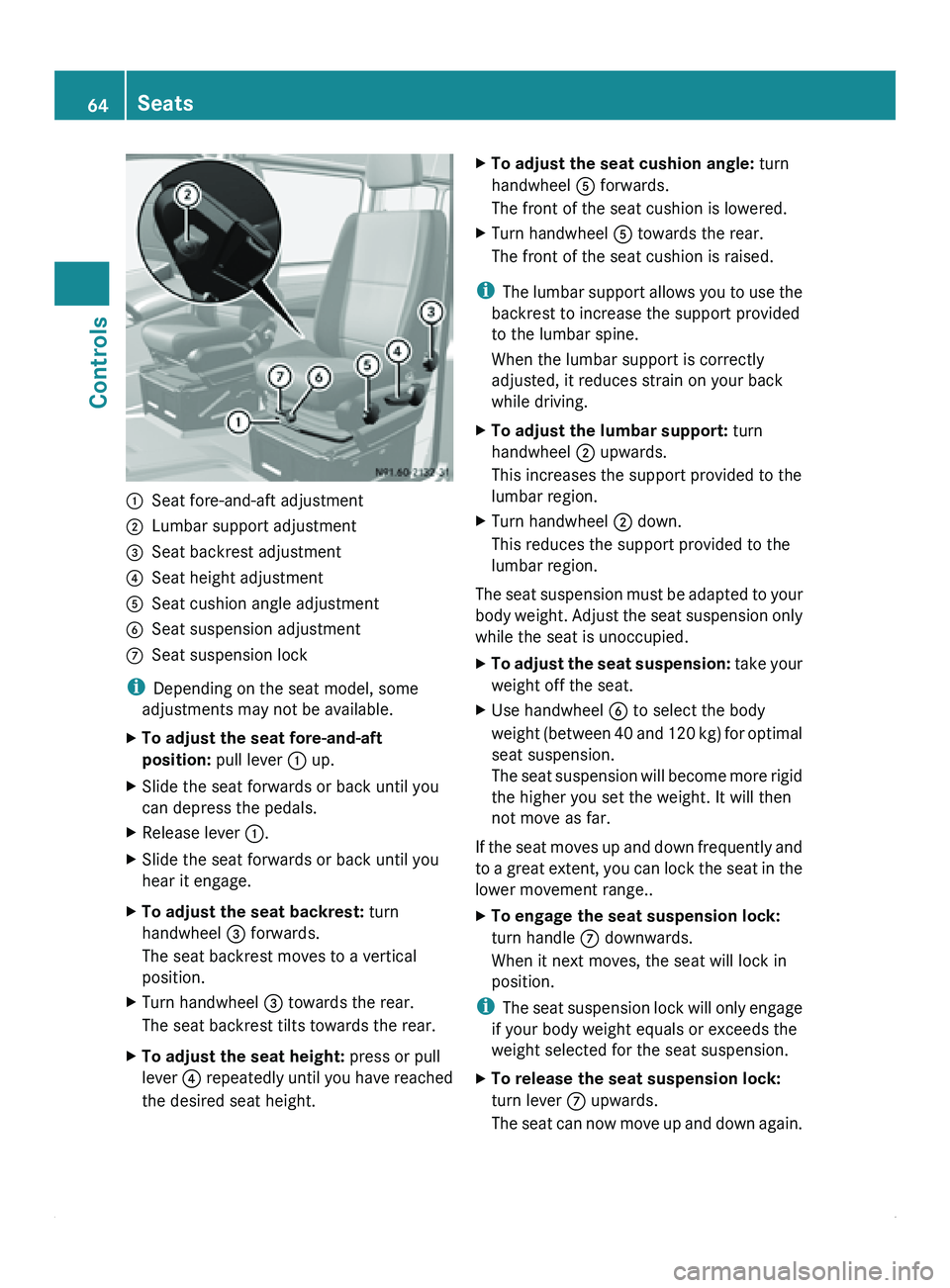
0046
Seat fore-and-aft adjustment
0047 Lumbar support adjustment
008A Seat backrest adjustment
0088 Seat height adjustment
0086 Seat cushion angle adjustment
0087 Seat suspension adjustment
006E Seat suspension lock
i Depending on the seat model, some
adjustments may not be available.
X To adjust the seat fore-and-aft
position: pull lever 0046 up.
X Slide the seat forwards or back until you
can depress the pedals.
X Release lever 0046.
X Slide the seat forwards or back until you
hear it engage.
X To adjust the seat backrest: turn
handwheel 008A forwards.
The seat backrest moves to a vertical
position.
X Turn handwheel 008A towards the rear.
The seat backrest tilts towards the rear.
X To adjust the seat height: press or pull
lever 0088 repeatedly
until
you have reached
the desired seat height. X
To adjust the seat cushion angle: turn
handwheel 0086 forwards.
The front of the seat cushion is lowered.
X Turn handwheel 0086 towards the rear.
The front of the seat cushion is raised.
i The lumbar
support
allows you to use the
backrest to increase the support provided
to the lumbar spine.
When the lumbar support is correctly
adjusted, it reduces strain on your back
while driving.
X To adjust the lumbar support: turn
handwheel 0047 upwards.
This increases the support provided to the
lumbar region.
X Turn handwheel 0047 down.
This reduces the support provided to the
lumbar region.
The seat suspension must be adapted to your
body weight.
Adjust
the seat suspension only
while the seat is unoccupied.
X To adjust the seat suspension: take your
weight off the seat.
X Use handwheel 0087
to select the body
weight (between 40
and 120 kg) for optimal
seat suspension.
The seat suspension will become more rigid
the higher you set the weight. It will then
not move as far.
If the seat moves up and down frequently and
to a great
extent, you can lock the seat in the
lower movement range..
X To engage the seat suspension lock:
turn handle 006E downwards.
When it next moves, the seat will lock in
position.
i The seat
suspension
lock will only engage
if your body weight equals or exceeds the
weight selected for the seat suspension.
X To release the seat suspension lock:
turn lever 006E upwards.
The seat can
now move up and down again.64
Seats
Controls
Page 67 of 292

Swiveling front seats
G
Warning
Do not start the engine unless the driver's and
co-driver's seats are facing in the direction of
travel and are locked in position. Only adjust
the seats when the vehicle is stationary and
the parking brake is applied. You could
otherwise lose control of the vehicle as a
result of sudden seat movements and thereby
cause an accident.
The safety systems only work when the
driver's and co-driver's seats are facing in the
direction of travel.
The driver's seat and co-driver's seat can be
rotated through 180°.
The seats engage when facing in the direction
of travel as well as when facing in the opposite
direction and also engage at an angle of 50°
to the door.
! When rotating the seats, make sure that
there is sufficient space to do so.
Move the seat forward or back first. This
will help to avoid contact with other parts
of the interior.
Push the handbrake lever down to the stop.
The parking brake or handbrake lever could
otherwise be damaged.
i Always slide the co-driver's seat forwards
before rotating it (Y page 64).
X Make sure that the parking brake has been
engaged and that the handbrake lever has
been pushed down to the stop
(Y page 112).
X Adjust the steering wheel to provide the
necessary space to rotate and adjust the
driver's seat ( Y
page 69). G
Warning
When releasing and rotating the seats, make
sure that you do not trap yourself or others.
Never place your hands under the seat or in
the vicinity of moving parts. Seat release (example co-driver's seat)
X
To rotate the seat: push lever 0046 on the
rear of the seat towards the center of the
vehicle and
slightly rotate the seat inwards.
The swiveling mechanism is now released.
X Release lever 0046.
X Rotate the seat inwards to the desired
position. G
Warning
When the seat is facing in the opposite
direction to the direction of travel and has
been moved to the rearmost position, you
could knock against the exposed frame and
be injured.
Therefore, always move the seat to a central
position above the seat base when leaving it
unoccupied. Inform others traveling with you
of this risk.
Twin co-driver's seat Seats
65Controls Z
Page 68 of 292

X
To fold the seat cushions forwards: lift
the seat cushion out of front
anchorage 0046.
X Pull the seat cushion forwards slightly and
out of rear anchorage 0047.
X Fold the rear edge of the seat cushion up.
i You can stow
various articles in the space
under the twin co-driver's seat.
X To fold the seat cushion back: fold down
the seat cushion by the rear edge.
X Slide the seat cushion under the seat
backrest into rear anchorage 0047
.
X Push down on the seat cushion at the front
until it engages in front anchorage 0046. Rear bench seat
G
Warning!
The unlocking levers at the foot of the rear
bench seat must lie parallel to the vehicle
floor. You may only install a rear bench seat
with two seats on the driver's side.
Information about this can be found at any
authorized Sprinter dealer.
The integral seat
belts can only protect you as
intended if you correctly install the prescribed
rear bench seats. For this reason, have a rear
bench seat with four seats installed only at a
qualified specialist workshop, e.g. an
authorized Sprinter dealer.
Keep the mounting shells of the bench seats
on the floor free from dirt and other objects.
The secure engaging of the locks is
guaranteed only in this way.
For safety reasons, have bench seat mounting
shells retrofitted only at an authorized
Sprinter dealer.
i Do not exceed the maximum permissible
number of seats for models registered as
passenger vehicles.
! For safety reasons, the rear bench seat
with four seats must be installed or
removed only at a qualified specialist workshop, e.g. an authorized Sprinter
dealer.
Removing two-seat or three-seat rear
benches The locking lever is located on the feet
underneath the bench seat.
0046
Lever
X Turn all levers 0046 for the bench seat fully
upwards.
The rear bench seat moves back into the
seat mounting recesses on the vehicle
floor.
X Lift the rear bench seat upwards out of the
seat mounting recesses.66
Seats
Controls
Page 105 of 292

Air-conditioning system/rear-
compartment air conditioning
X
On vehicles with rear-compartment air
conditioning, make sure that the rear-
compartment climate control is activated
(Y page 100).
X Press the 0097 button to reduce or the
0099 button to increase the airflow.
The blower speeds are shown in bars next
to the buttons. Defrosting the windows
G
Warning
Clear all windows of ice or snow before setting
off. Otherwise, impaired visibility could
endanger you and others.
Only use the following settings until the
windows are clear again.
X Vehicles with window heating:
switch on
the front and/or rear window defroster
(
Y page 95).
Heating X
Set temperature control 0046 and airflow
control 0047 to 0087 (Y page 98).
X Set air-distribution control 0088 to
0080 0087 (Y page 98).
X Close the center air vents and the air
outlets for the headroom and the rear
compartment (
Y
page 101).
X Direct the side air vents towards the side
windows and open the demister vents for
the side windows ( Y page 101).
Air-conditioning system X
Set temperature control 0046 to
0087 (Y page 99).
X Press the 0099 button until the maximum
blower output is reached.
All bars in the display next to the button
light up. X
Set air-distribution control 0086 to
0080 0087 (Y page 99).
X Close the center air vents and the air
outlets for the headroom and the rear
compartment (Y
page 101).
X Direct the side air vents towards the side
windows and open the demister vents for
the side windows ( Y page 101). Defrosting windows
Windows fogged up on the inside Only use the following settings until the
windows are clear again.
X
Vehicles with window heating: switch on
the front and/or rear window defroster
(
Y page 95).
X Switch off air-recirculation mode
(Y page 104).
Heating
X Set temperature control 0046 to a higher
temperature ( Y page 98).
X Set airflow control 0047 to a higher blower
setting. It should
be set at least to level two
(Y page 98).
X Set air-distribution control 0088 to
0080 0087 (Y page 98).
If the windows still fog up, set the control as
described for defrosting (Y page 103).
Air-conditioning system
X Activate cooling with air dehumidification
(Y page 100).
X Press the 0068 button.
The reheat function is switched on. The
indicator lamp in the switch lights up.
To switch off
the reheat function, press the
0068 button again. The indicator lamp in
the button goes out. Climate control
103
Controls Z
Page 107 of 292

may be highly flammable and could explode if
heated.
In particular, make sure that the containers
described above are not placed in the hot air
flow from the
auxiliary heating system. Do not
stow such containers directly next to or on top
of the heater.
You could otherwise endanger yourself and
others.
The auxiliary heating system operates
independently of the engine and
complements the vehicle heating or air
conditioning.
You can set the auxiliary heating at an outside
temperature of up to 39 ‡ (4 †) in order to:
R pre-heat the vehicle interior
R additionally warm the coolant, thereby
conserving the engine and saving fuel
R support the vehicle's heating system while
the engine is running and outside
temperatures are low (heater booster
function)
i If the outside temperature rises above
39 ‡ (4 †), the auxiliary heating and heater
booster function switch off automatically.
! Switch on the auxiliary heating system at
regular intervals (at least once a month) for
approximately 10 minutes.
Make sure that the flow of hot air is not
blocked. Otherwise, the auxiliary heating
will overheat and switch off.
i If the interior motion sensor ( Y page 62)
is armed and the auxiliary heating is
switched on, it is possible that the interior
temperature monitoring may cause a false
alarm. In this case, either deactivate the
interior motion sensor or switch off the
auxiliary heating. Before switching on X
The fuel tank must be at least one-quarter
full.
X Set the desired temperature using the
temperature control of the heating or the
air-conditioning system (Y
page 100).
X Set the air distribution as required
(Y page 102).
X Open the center and side air vents and set
them to the middle position (Y page 101).
i The auxiliary heating automatically
switches to heater booster mode after the
engine is started.
Operating using the switch 0046
To switch the auxiliary heating on/off
0047 To switch the heater booster function on/
off (Y page 107)
X To switch on the auxiliary heating: press
the 0086
switch for longer than two
seconds.
R The auxiliary heating heats or ventilates
the interior to the temperature that you
have set.
R The blower switches to the lowest speed.
R The red indicator lamp in the switch
comes on. Climate control
105
Controls Z
Page 110 of 292
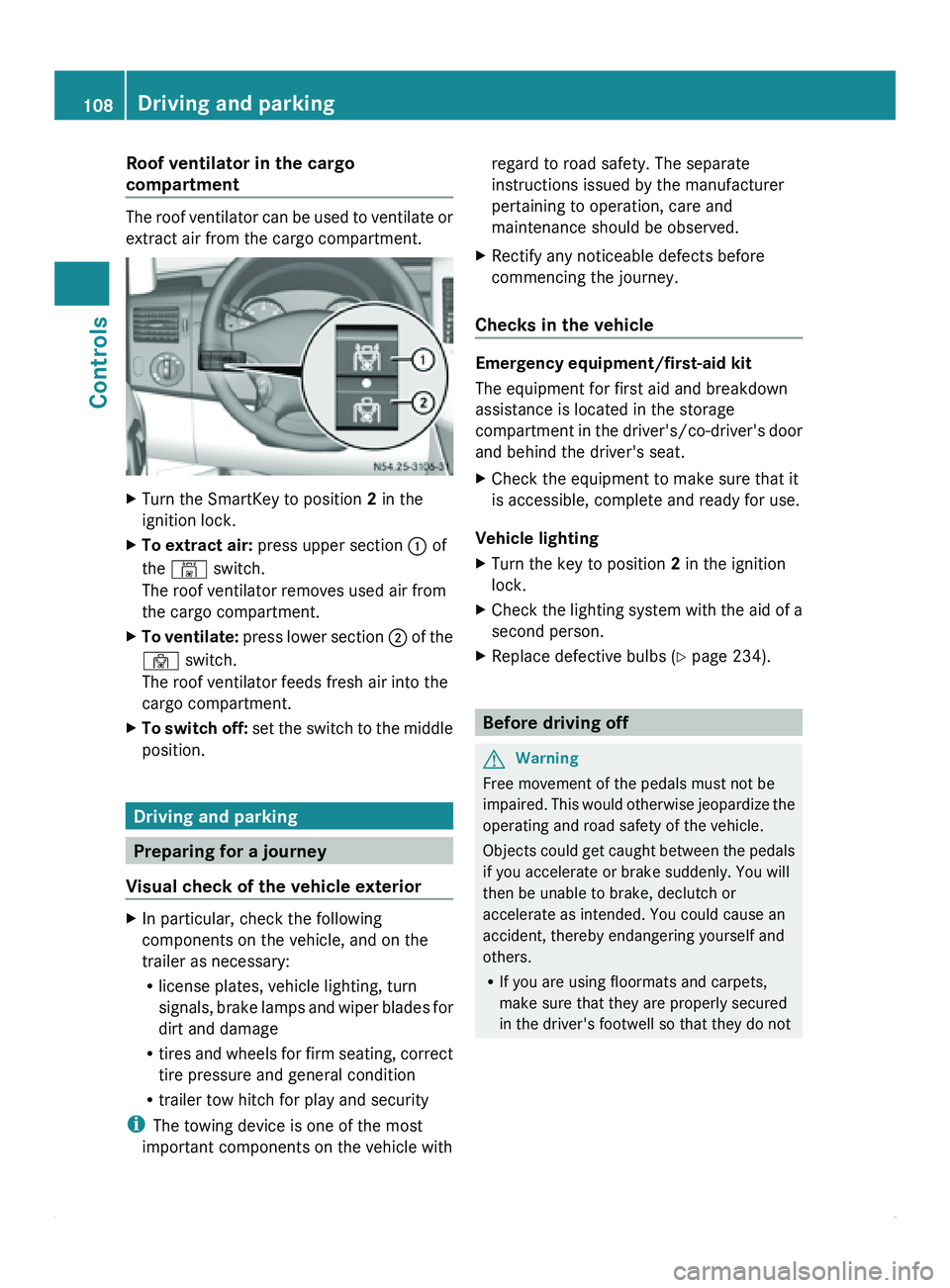
Roof ventilator in the cargo
compartment
The roof ventilator can be used to ventilate or
extract air from the cargo compartment.
X
Turn the SmartKey to position 2 in the
ignition lock.
X To extract air: press upper section 0046 of
the 00B4 switch.
The roof ventilator removes used air from
the cargo compartment.
X To ventilate: press lower section 0047 of the
00B3 switch.
The roof ventilator feeds fresh air into the
cargo compartment.
X To switch off: set the
switch to the middle
position. Driving and parking
Preparing for a journey
Visual check of the vehicle exterior X
In particular, check the following
components on the vehicle, and on the
trailer as necessary:
R
license plates, vehicle lighting, turn
signals, brake lamps
and wiper blades for
dirt and damage
R tires and wheels for firm seating, correct
tire pressure and general condition
R trailer tow hitch for play and security
i The towing device is one of the most
important components on the vehicle with regard to road safety. The separate
instructions issued by the manufacturer
pertaining to operation, care and
maintenance should be observed.
X Rectify any noticeable defects before
commencing the journey.
Checks in the vehicle Emergency equipment/first-aid kit
The equipment for first aid and breakdown
assistance is located in the storage
compartment in
the
driver's/co-driver's door
and behind the driver's seat.
X Check the equipment to make sure that it
is accessible, complete and ready for use.
Vehicle lighting
X Turn the key to position 2 in the ignition
lock.
X Check the lighting system with the aid of a
second person.
X Replace defective bulbs ( Y page 234). Before driving off
G
Warning
Free movement of the pedals must not be
impaired. This would
otherwise jeopardize the
operating and road safety of the vehicle.
Objects could get caught between the pedals
if you accelerate or brake suddenly. You will
then be unable to brake, declutch or
accelerate as intended. You could cause an
accident, thereby endangering yourself and
others.
R If you are using floormats and carpets,
make sure that they are properly secured
in the driver's footwell so that they do not108
Driving and parking
Controls
Page 111 of 292
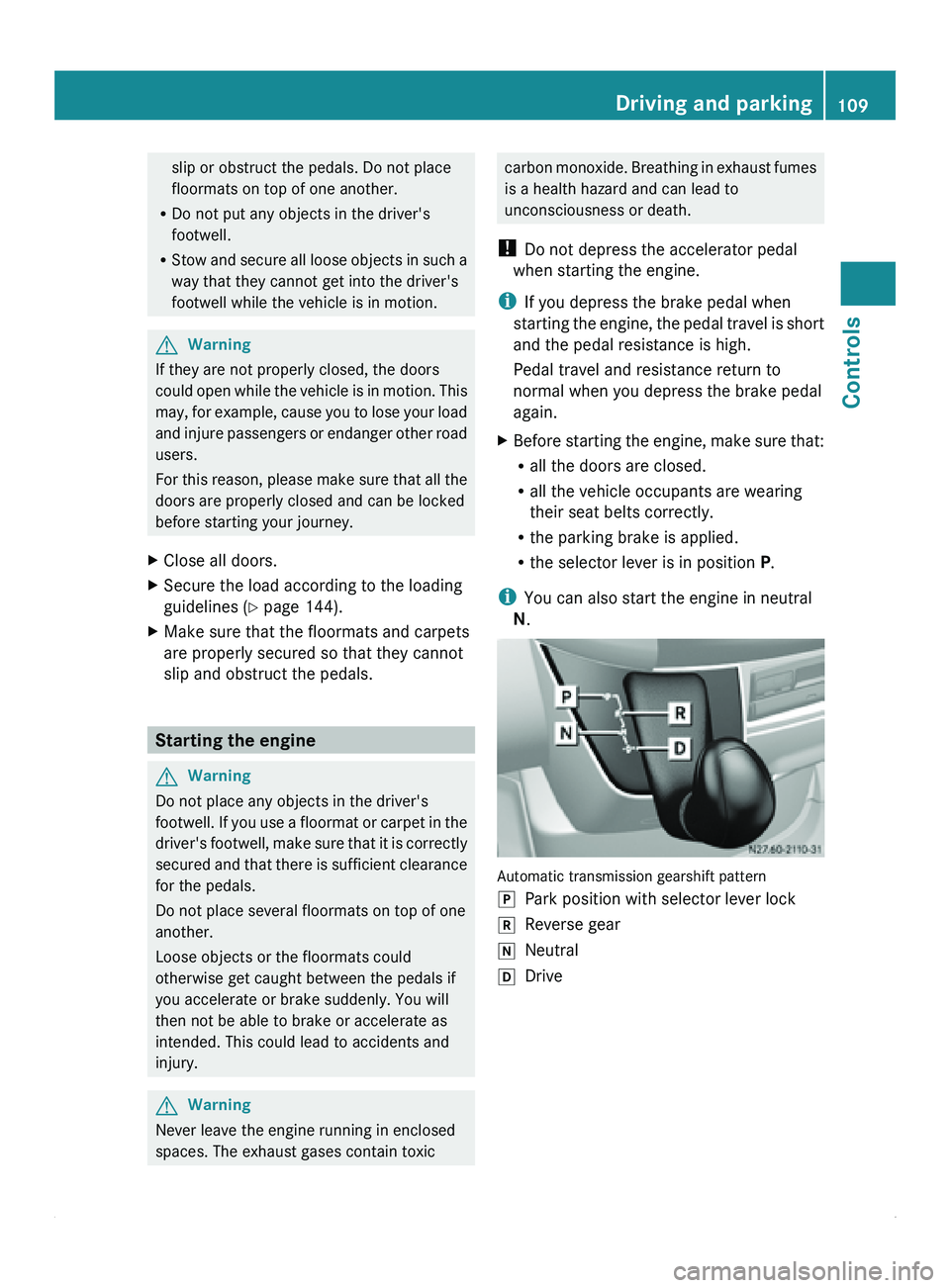
slip or obstruct the pedals. Do not place
floormats on top of one another.
R Do not put any objects in the driver's
footwell.
R Stow and secure
all loose objects in such a
way that they cannot get into the driver's
footwell while the vehicle is in motion. G
Warning
If they are not properly closed, the doors
could open while
the vehicle is in motion. This
may, for example, cause you to lose your load
and injure passengers or endanger other road
users.
For this reason, please make sure that all the
doors are properly closed and can be locked
before starting your journey.
X Close all doors.
X Secure the load according to the loading
guidelines ( Y page 144).
X Make sure that the floormats and carpets
are properly secured so that they cannot
slip and obstruct the pedals. Starting the engine
G
Warning
Do not place any objects in the driver's
footwell. If you
use a floormat or carpet in the
driver's footwell, make sure that it is correctly
secured and that there is sufficient clearance
for the pedals.
Do not place several floormats on top of one
another.
Loose objects or the floormats could
otherwise get caught between the pedals if
you accelerate or brake suddenly. You will
then not be able to brake or accelerate as
intended. This could lead to accidents and
injury. G
Warning
Never leave the engine running in enclosed
spaces. The exhaust gases contain toxic carbon monoxide.
Breathing in exhaust fumes
is a health hazard and can lead to
unconsciousness or death.
! Do not depress the accelerator pedal
when starting the engine.
i If you depress the brake pedal when
starting the engine,
the pedal travel is short
and the pedal resistance is high.
Pedal travel and resistance return to
normal when you depress the brake pedal
again.
X Before starting the engine, make sure that:
R
all the doors are closed.
R all the vehicle occupants are wearing
their seat belts correctly.
R the parking brake is applied.
R the selector lever is in position P.
i You can also start the engine in neutral
N. Automatic transmission gearshift pattern
0060
Park position with selector lever lock
0061 Reverse gear
005F Neutral
005E Drive Driving and parking
109
Controls Z